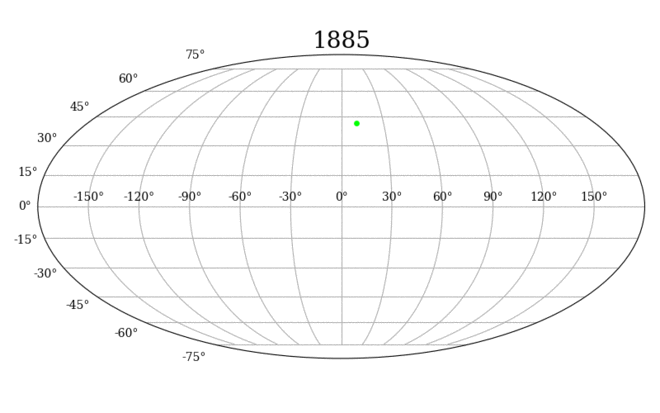History of supernova observation facts for kids
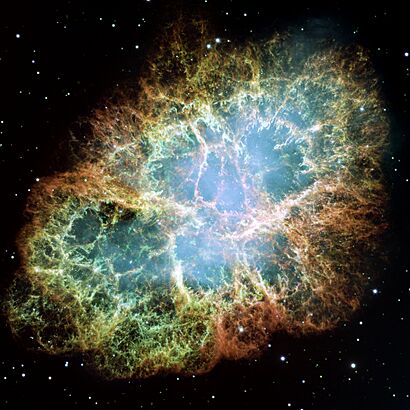
The known history of observing supernovae goes back to the year 1006 AD. A supernova is a huge, bright explosion of a star. Before 1006 AD, any ideas about seeing supernovae are just guesses.
After people started using telescopes, we could find supernovae in other galaxies. These explosions give us important clues about how far away galaxies are. Scientists have also created good models to understand how supernovae behave. We are now learning more about how supernovae help new stars form.
Contents
Early Discoveries of Supernovae
| Year | Where it was seen | How bright it was (m) |
What we know about it |
|---|---|---|---|
| 185 | Centaurus | −6 | Thought to be a supernova, but could have been a comet |
| 386 | Sagittarius | +1.5 | Uncertain, possibly a supernova or a nova (smaller explosion) |
| 393 | Scorpius | −3 | Possibly a supernova or a nova |
| 1006 | Lupus | −7.5±0.4 | Certain: We know its remains |
| 1054 | Taurus | −6 | Certain: We know its remains and a pulsar (spinning star) |
| 1181 | Cassiopeia | −2 | Likely not a supernova, but a very active star |
| 1572 | Cassiopeia | −4 | Certain: We know its remains |
| 1604 | Ophiuchus | −2 | Certain: We know its remains |
In the year 185 CE, astronomers in China wrote about a bright new star. They saw it took about eight months to fade away. It sparkled like a star and did not move like a comet. These notes match what a supernova looks like. This is thought to be the oldest sure record of a supernova.
The SN 185 event might also have been written about in Roman books. But no records have lasted until today. A gas cloud called RCW 86 is likely what's left of this explosion. Recent X-ray studies show it matches the expected age. The event was also in the Book of the Later Han, a history of China.
In 393 CE, the Chinese wrote about another "guest star", SN 393. It appeared in the part of the sky we now call Scorpius. Other possible supernovae might have been seen in 369 CE, 386 CE, 437 CE, 827 CE and 902 CE. But these have not been linked to any supernova remains. So they are still just possible events. Over 2,000 years, Chinese astronomers wrote about twenty such possible events. Later, Islamic, European, and possibly Indian observers also noted explosions.
The supernova SN 1006 appeared in the southern sky in the Lupus area in 1006 CE. This was the brightest star ever recorded in the night sky. People in China, Egypt, Iraq, Italy, Japan, and Switzerland saw it. It might also have been seen in France, Syria, and North America.
An Egyptian astrologer, Ali ibn Ridwan, said this star was a quarter as bright as the Moon. Today's astronomers have found the faint remains of this explosion. They figured out it was only 7,100 light-years from Earth.
Supernova SN 1054 was another event seen by many people. Astronomers wrote about it in 1054 CE. It might have been drawn by the Ancestral Puebloans in New Mexico. They drew a four-pointed star shape on rocks. This explosion happened in the Taurus area. It created the famous Crab Nebula.
At its brightest, SN 1054 may have been four times brighter than Venus. It stayed visible during the day for 23 days. It could be seen in the night sky for 653 days.
There are fewer records of supernova SN 1181. This explosion happened in the Cassiopeia area. It was just over a century after SN 1054. Chinese and Japanese astronomers noted it. The pulsar 3C58 was once thought to be what was left of this star. But in 2021, a new idea came up. A nebula called Pa 30, about 1000 years old, might be the true remnant.
The Danish astronomer Tycho Brahe was known for carefully watching the night sky. He used his observatory on the island of Hven. In 1572, he saw a new star, also in Cassiopeia. This supernova, later called SN 1572, was linked to its remains in the 1960s.
Many people in Europe at that time believed Aristotle's idea. He thought the sky beyond the Moon never changed. So, observers argued that the new star was just something in Earth's air. But Tycho noticed the object stayed still night after night. It never changed its parallax (how it seems to shift when you look from different places). This meant it had to be very far away.
He wrote about his findings in a small book in 1573. Its Latin title meant "Concerning the new and previously unseen star." The modern word nova for cataclysmic variable stars (stars that suddenly get brighter) comes from this book's title.
The most recent supernova seen in our own Milky Way galaxy was SN 1604. It was seen on October 9, 1604. Several people, like Johannes van Heeck, noticed this star appear suddenly. But Johannes Kepler became famous for studying it carefully. He wrote about his observations in a book.
Galileo, like Tycho, tried to measure the parallax of this new star. He then argued against the idea that the heavens never changed. The remains of this supernova were found in 1941. This happened at the Mount Wilson Observatory.
Supernovae Seen with Telescopes
For a while, no one really knew what supernovae were. Observers slowly began to see that some stars changed their brightness over time. Both John Russell Hind in 1848 and Norman Pogson in 1863 had mapped stars that suddenly got brighter. But astronomers didn't pay much attention to these.
Finally, in 1866, English astronomer William Huggins made the first observations of a nova using a spectroscope. He found hydrogen in the unusual light from the star T Coronae Borealis. Huggins thought a huge explosion was the cause. His work made other astronomers interested.
In 1885, a bright flash like a nova was seen in the direction of the Andromeda Galaxy. Ernst Hartwig in Estonia saw it. This star, S Andromedae, became as bright as a 6th magnitude star. It was brighter than the whole center of the galaxy. Then it faded like a nova.
In 1917, George W. Ritchey measured the distance to the Andromeda Galaxy. He found it was much farther away than thought before. This meant S Andromedae, which was actually inside the galaxy, released a lot more energy than a typical nova.
Scientists Walter Baade and Fritz Zwicky did early work on this new type of nova in the 1930s. They worked at Mount Wilson Observatory. They called S Andromedae a typical supernova. They said it was an explosion that released as much energy as the Sun does in 10 million years.
They thought this energy came from ordinary stars collapsing into neutron stars. Zwicky first used the name super-novae in a talk in 1931. He then used it publicly in 1933. By 1938, the hyphen was gone, and the name "supernova" was commonly used.
Supernovae are thought to happen about once every 50 years in the Milky Way. But we can find and study them more often by looking at distant galaxies. Zwicky started the first supernova search in 1933. Josef J. Johnson joined him in 1936. They used a telescope at Palomar observatory. They found twelve new supernovae in three years. They did this by comparing new photos to old ones of distant galaxy areas.
In 1938, Walter Baade was the first to say that the Crab Nebula was the remains of SN 1054. He noticed it looked like a planetary nebula (a cloud of gas from a dying star). But its expansion speed was too fast for that type of object.
In the same year, Baade suggested using Type Ia supernovae to measure distances. Later, Allan Sandage and Gustav Tammann improved this method. Type Ia supernovae became a kind of standard candle. This means they have a known brightness, so we can use them to measure huge distances in space.
Rudolph Minkowski first sorted these distant supernovae by their light in 1941. He put them into two types. This was based on whether they had hydrogen in their light spectrum. Zwicky later suggested more types, but these are not used anymore. Today, we have a more detailed classification system.
After World War II, Fred Hoyle studied how different elements in the universe were made. In 1946, he suggested that a huge star could create the needed nuclear reactions. He thought these reactions were why a star would collapse. The collapsing star would then explode, sending elements into space. Hoyle and William Fowler developed the idea that fast nuclear fusion powers a supernova explosion in the 1960s.
The first computer-controlled search for supernovae started in the 1960s. It was at Northwestern University. They built a telescope in New Mexico that a computer could move. The telescope showed a new galaxy every minute. Observers checked the view on a TV screen. They found 14 supernovae in two years this way.
Supernovae from 1970 to 1999
The main idea for Type Ia supernova explosions today came from Whelan and Iben in 1973. It's based on a star stealing mass from a nearby companion star. The light from SN1972e in NGC 5253 was watched for over a year. After its brightest point, the supernova faded at a steady rate. This rate was almost the same as the decay of cobalt-56 (56Co), which has a half-life of 77 days.
The explosion model predicts that the star makes about one Sun's worth of nickel-56 (56Ni). The 56Ni then decays to 56Co. The decay of nickel and cobalt provides the energy that the supernova gives off later. Because the energy and fading rate matched, this model was quickly accepted.
By watching the light from many Type Ia supernovae, scientists found they all reach a similar peak brightness. By measuring this brightness, we can guess how far away their home galaxy is. So, these supernovae are very useful as a standard candle for measuring distances in space.
In 1998, two groups of scientists found something surprising. The most distant Type Ia supernovae looked dimmer than expected. This suggested that the universe's expansion might be speeding up.
No supernova has been seen in the Milky Way since 1604. But it seems one exploded in Cassiopeia about 300 years ago, around 1667 or 1680. The remains of this explosion, Cassiopeia A, are hidden by dust. This is likely why it wasn't seen clearly. But we can see it using other types of light. It is now the brightest radio source outside our solar system.
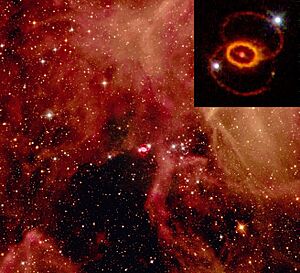
In 1987, Supernova 1987A in the Large Magellanic Cloud was seen just hours after its light reached Earth. It was the first supernova found by its neutrino particles. It was also the first seen across all types of light. This supernova was close enough for detailed study. It was the first chance to test modern supernova theories against real observations.
The number of supernovae found grew steadily in the 1900s. In the 1990s, several automatic search programs started. The Leuschner Observatory Supernova Search began in 1992. The Berkeley Automated Imaging Telescope program joined it that same year. These were followed in 1996 by the Katzman Automatic Imaging Telescope at Lick Observatory. This telescope was mainly used for the Lick Observatory Supernova Search (LOSS). By 2000, the Lick program found 96 supernovae. This made it the most successful search program in the world.
In the late 1990s, it was suggested that new supernova remains could be found. This was by looking for gamma rays from the decay of titanium-44. This element has a half-life of 90 years. Its gamma rays can travel through the galaxy easily. This allows us to see any remains from the last thousand years or so. Two sources were found: the known Cassiopeia A remains, and RX J0852.0-4622. This second one was just found overlapping the Vela Supernova Remnant.
This new remnant (RX J0852.0-4622) seemed to be in front of the larger Vela Supernova Remnant. The gamma rays from titanium-44 showed it must have exploded recently (maybe around 1200 AD). But there is no old record of it. The amount of gamma rays and X-rays means the supernova was fairly close to us. Maybe 600 light-years away. If so, this is surprising. Supernovae less than 600 light-years away are thought to happen less than once every 100,000 years.
Supernovae from 2000 to Today
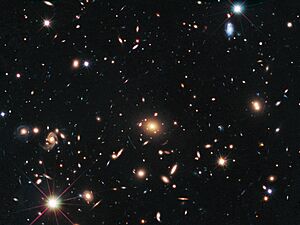
SN 2003fg was found in a new galaxy in 2003. Scientists studied this supernova as it happened. It raised big questions because it seemed more massive than what the Chandrasekhar limit (a star's maximum stable mass) would allow.
First seen in September 2006, the supernova SN 2006gy was in a galaxy called NGC 1260. This galaxy is 240 million light-years away. SN 2006gy was the largest and brightest supernova ever seen until SN 2005ap was confirmed in 2007. The explosion was at least 100 times brighter than any supernova seen before. The star that exploded was thought to be 150 times bigger than the Sun.
Even though it looked a bit like a Type Ia supernova, hydrogen was found in its light. SN 2006gy is likely a pair-instability supernova. SN 2005ap, found by Robert Quimby (who also found SN 2006gy), was about twice as bright as SN 2006gy. It was about 300 times brighter than a normal Type II supernova.
On May 21, 2008, astronomers announced they had caught a supernova exploding on camera for the first time. By chance, a burst of X-rays was seen while looking at galaxy NGC 2770. This galaxy is 88 million light-years from Earth. Many telescopes were quickly pointed there. They captured what was named SN 2008D. "This showed that the big X-ray burst was the birth of a supernova," said Alicia Soderberg.
Caroline Moore, a young amateur astronomer, found supernova SN 2008ha in late November 2008. She was 14 and was thought to be the youngest person to find a supernova. However, in January 2011, 10-year-old Kathryn Aurora Gray from Canada found one. This made her the youngest ever. Gray, her father, and a friend spotted SN 2010lt. It was a magnitude 17 supernova in galaxy UGC 3378. This galaxy is in the Camelopardalis area, about 240 million light-years away.
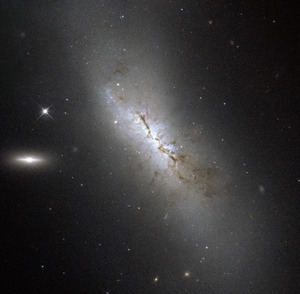
In 2009, scientists found nitrates in ice cores from Antarctica. These nitrates were at depths that matched the known supernovae of 1006 and 1054 AD. They also found nitrates from around 1060 AD. The nitrates were likely formed from gases created by gamma rays from the supernovae. This method could help find supernovae from thousands of years ago.
On November 15, 2010, astronomers using NASA's Chandra X-ray Observatory announced a discovery. While looking at the remains of SN 1979C in the galaxy Messier 100, they found an object. It could be a young, 30-year-old black hole. NASA also said it might be a spinning neutron star that sends out high-energy particles.
On August 24, 2011, the Palomar Transient Factory survey found a new Type Ia supernova (SN 2011fe). It was in the Pinwheel Galaxy (M101). It was found soon after it exploded. Being only 21 million light-years away and found so early, it will help scientists learn more about how these supernovae begin.
On March 16, 2012, a Type II supernova, called SN 2012aw, was found in M95.
On January 22, 2014, students at the University of London Observatory saw an exploding star. It was SN 2014J in the nearby galaxy M82 (the Cigar Galaxy). At about 12 million light-years away, it is one of the closest supernovae seen in recent decades.
A few weeks after a star exploded in the spiral galaxy NGC 2525 in January 2018, NASA's Hubble Space Telescope took photos. For nearly a year, it took pictures of the resulting Type Ia supernova, called SN 2018gv.
What's Next for Supernova Hunting?
It's thought that supernovae happen about twice every century in a galaxy the size of the Milky Way. This is more than we actually see. This means some explosions are hidden from Earth by dust in space. New tools that can see different kinds of light, along with neutrino detectors, mean we will almost certainly find the next one.
The Vera C. Rubin Observatory in Chile is expected to find three to four million supernovae. This will happen during its ten-year survey. It will find them across a wide range of distances.
See also



